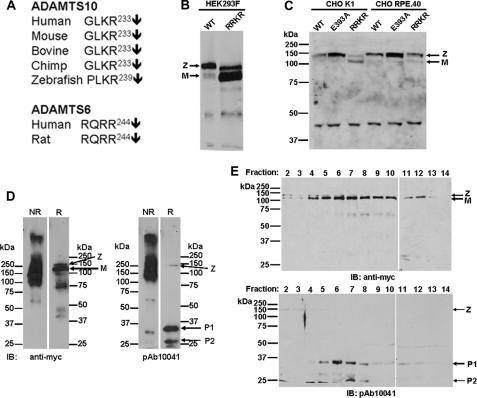FIGURE 5.
Wild-type ADAMTS10 is normally resistant to furin processing but can be substantially processed to mature form by optimization of furin recognition sequence. A, sequence alignment of the putative furin cleavage site of ADAMTS10 and its closest homolog, ADAMTS6, from the indicated species. Note that the cleavage site of ADAMTS6 matches the desired RX(K/R)R consensus but that ADAMTS10 consistently lacks the P4 Arg residue. B, site-directed mutagenesis of ADAMTS10 was used to convert the wild-type (WT) G230L231KR sequence to R230R231KR (RRKR), and both forms were analyzed by Western blot of the conditioned medium of transfected HEK293F cells. Note that the major species detected in WT ADAMTS10 is the zymogen (Z), whereas the mature form (M) constitutes the major species following ADAMTS10-RRKR transfection. C, analysis of the indicated ADAMTS10 constructs in medium of transiently transfected CHO-K1 cells or furin-deficient CHO-RPE.40 cells by reducing SDS-PAGE and Western blotting with anti-myc. Note that the prevalent mature form (M) of the ADAMTS10-RRKR mutant is decreased in intensity relative to the zymogen (Z) in CHO-RPE.40, cells indicating that it was the consequence of furin processing. In contrast, there is little change in amount of the mature and zymogen forms observed in wild-type ADAMTS10 (WT) or ADAMTS10 E393A in either cell line. D, comparison of ADAMTS10-RRKR migration under reducing (R) and non-reducing (NR) conditions using anti-myc or the anti-propeptide antibody pAb 10041. Note the similar migration pattern observed with both antibodies under non-reducing conditions with the exception of some cleaved propeptide observed with pAb 10041. In contrast, reducing Western blots with anti-myc show a prevalent 120-kDa band corresponding to mature ADAMTS10 (M) with a low prevalence of zymogen (Z), and pAb 10041 showed prominent species of 35 (P1) and 27 kDa (P2) arising from the processed ADAMTS10 propeptide. E, Western blots following reducing SDS-PAGE of fractions collected from analytical gel filtration chromatography of ADAMTS10-RRKR. Note that cleaved ADAMTS10 propeptide species P1 and P2 co-elute with the mature ADAMTS10 in fractions 4–12. IB, immunoblot.

